Are you keeping up with the latest remote work data and using it to support your team?
Are you prepared for the newest concerns people have in an increasingly WFH (Work From Home) world?
Buffer recently published its State of Remote Work report for 2022. In it, they collected answers from over 2000 remote workers about their working conditions and needs.
We’ve been following Buffer’s reports over the years and want to show you how remote work has evolved during that time.
This post also includes data about remote work from companies such as Gallup, PwC, and others. We've read the report so you don't have to; we've compiled the most important insights managers like you should know to help you deal with the challenges of leading teams who do remote work.
Buffer’s 2022 State of Remote Work - What Changes Could Be Impacting Your Team
This post is split up into 3 sections:
- Why everyone is adopting remote work on a permanent basis (and what that means for you)
- Is death-by-meeting still causing us issues?
- The biggest struggles with remote work in the past 3 years
Let’s analyze the data from the past three years and understand what it means for you and your team.

Are companies really allowing remote work permanently (at least some of the time)?
Yes, and there are no signs of this trend stopping. In 2021, 46% of organizations surveyed by Buffer were planning to allow employees to work remotely on a permanent basis. In 2022, that percentage has risen significantly to a dominant 72%. While the question above wasn’t included in the 2020 survey, 98% of participants that year told Buffer they’d like the option of working remotely for the rest of their lives.
This matches with PwC’s findings as well. In their survey, 43% of organizations have confirmed they’ll keep using a hybrid model after the pandemic is over. As you can see in the image below, the option of working remotely is the most frequently offered perk by the companies in the survey.
It even topped career development opportunities and better compensation!

Flexibility is a must, but be ready for these challenges with hybrid teams
Working remotely is one of the keys to retention in 2022. In one of their surveys, Gallup asked people if they would look for a new job if their employer stopped offering remote-work options.
An incredible 54% of employees currently working exclusively from home said that would cause them to quit and 38% of hybrid workers said the same. Many people are not interested in returning to the office.
To prevent turnover, companies are increasingly listening to their workers’ wishes. And while many of them are adopting a hybrid model, this is often the hardest approach to pull off compared to all remote or all in office.
Hybrid teams are difficult to manage due to:
- Information inequality: When some people can overhear conversations and quickly be pulled into a meeting in person, those working remotely are left at a disadvantage and out of the loop.
- Feelings of loneliness: We are social creatures, and connecting with someone using a screen isn’t the same as face-to-face conversations.
- Different time zones: If you work in time zones that don’t overlap, remote workers could miss out on key things or just be unavailable for spontaneous meetings.
- Career growth stalling: Many leaders tend to promote people who work in an office first because visibility on a regular basis makes an impression that's hard to ignore compared to someone only seen on a screen.
To combat this, you have to proactively work on supporting your team. Here are several ways to do that.

Leading hybrid teams is about making everyone feel included
To address your team members working remotely feeling out of the loop, you build these habits:
- Be Intentional: If you hear something they should know, message them about it immediately, or write down a note and share it with them when you have time.
- Pay Down Communication Debt: Use your one on ones to share with them the things they may have missed, and encourage them to ask questions when they feel out of the loop.
- Be Proactive and Inclusive: When a group is meeting in person, make sure remote team members that should join are invited and called. If it's important and they're unavailable, consider scheduling the meeting for later, or holding off on decisions until they can contribute.
This may take getting used to and feel a bit strange in the beginning, but it’s necessary. You need to work on keeping your remote team informed and included both for their morale, and for you to maximize the ideas, abilities, and knowledge of your team.
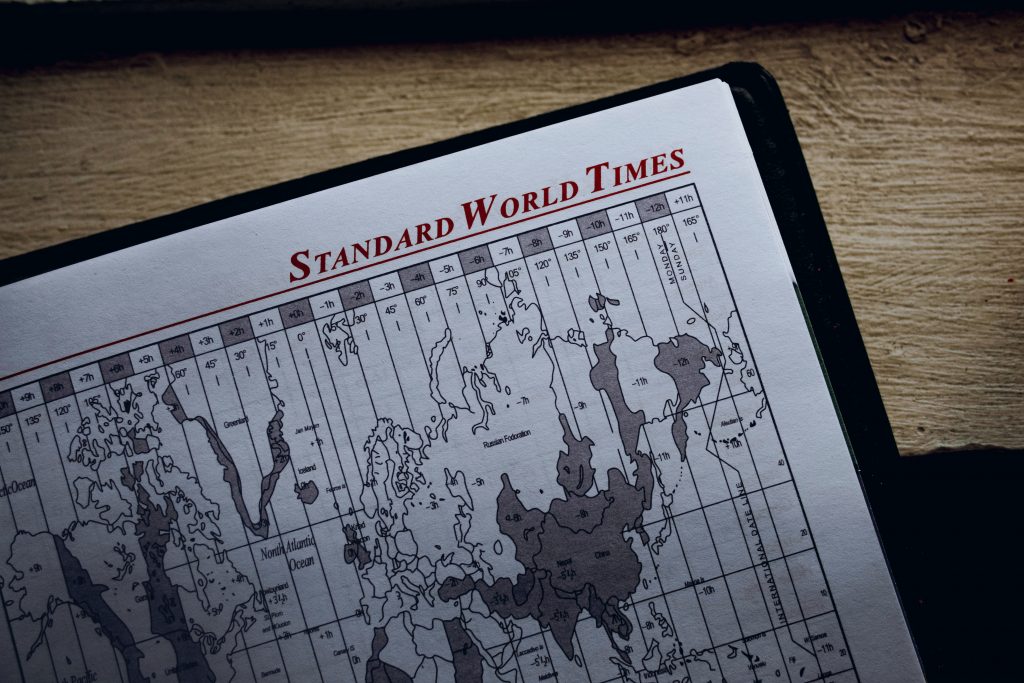
Tips for building bonds across time zones
Remote team members are often unable to build deeper relationships with the rest of your team. To address that, look for opportunities for everyone to socialize, no matter where they're located.
Here are some activities we’ve tried and heard from others work well to help you build bonds across locations:
- Open your meetings with bonding/ice-breaker questions
- Play pub-style team trivia together
- Try remote-friendly games (Among Us, Codenames, etc)
- Have team members take turns giving tours of their hometowns via Facetime
- Have a virtual pizza party with Pizzatime.xyz
Building rapport is particularly hard if you’re scattered all across the globe. Use these activities to overcome the physical distance and offer your team opportunities to get to know each other frequently.
The biggest struggles with remote work in the past 3 years
There’s a pretty worrying trend going on with the biggest issues among remote workers. Burnout, loneliness, and distractions continue to be challenges for many working remotely. Adding to this, is ‘Not being able to unplug’ at the top of people’s concerns for the second year in a row.
In 2020, 18% of people chose this as their biggest issue with working from home - enough to place it 3rd on the list behind loneliness and communication issues.
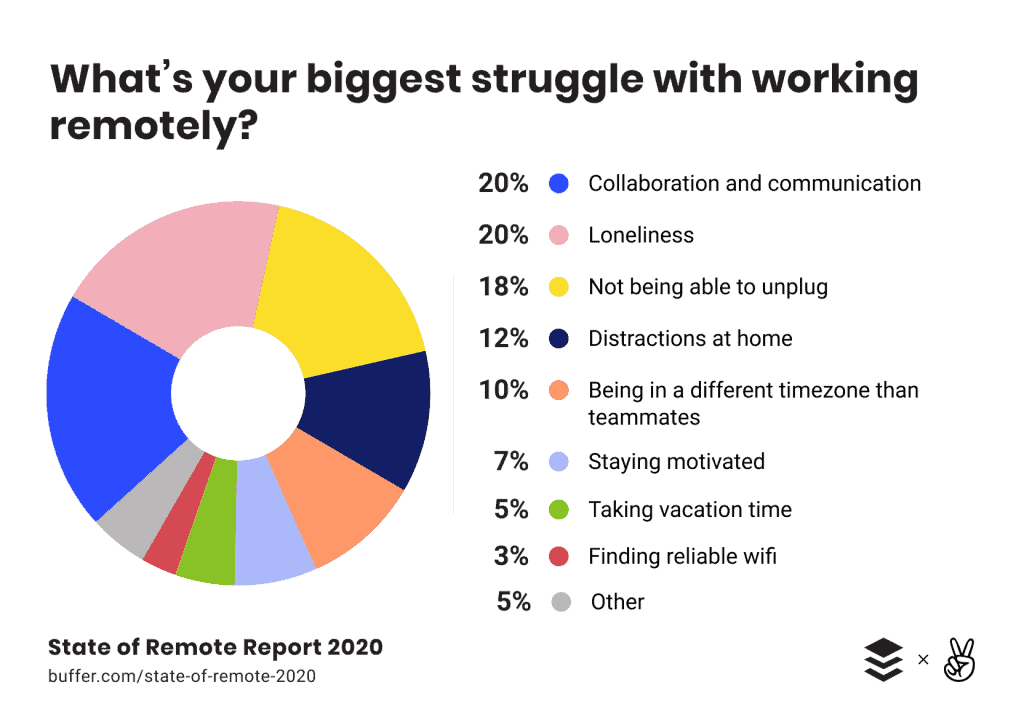
In 2021, it was the leading issue for both people who were remote workers before COVID (26%) and those who shifted as a result of the pandemic (27%).
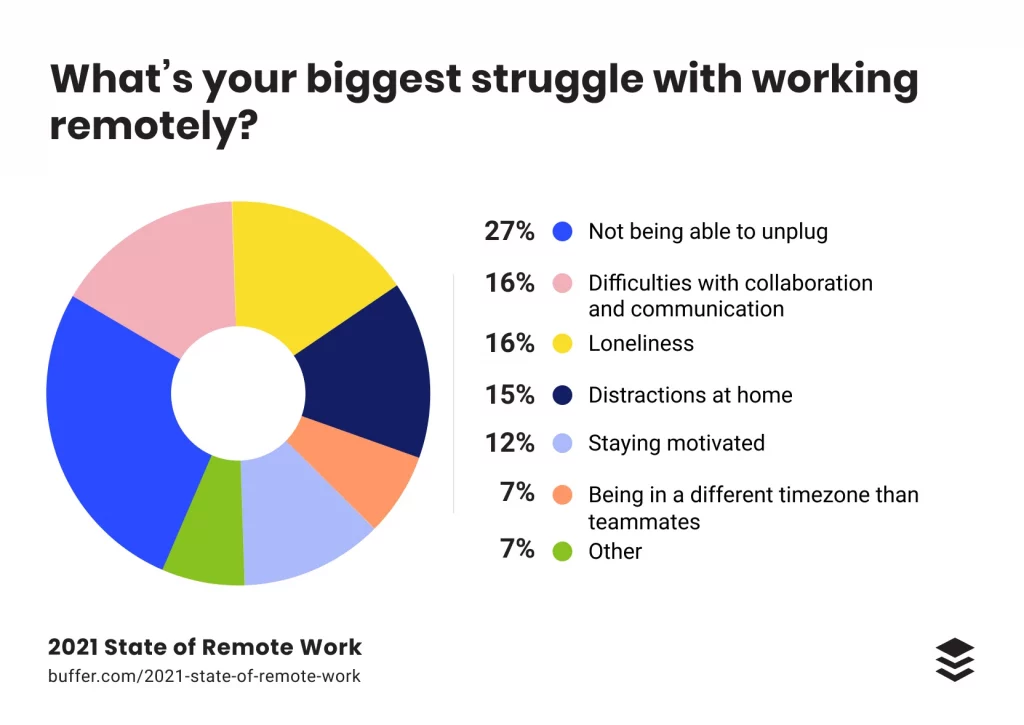
This year, it stayed at the top, with 25% of correspondents still being unable to separate their free time from work.
With so many working from home due to COVID lockdowns and offices closed, it’s no wonder people have issues with switching off. That’s why if you want to lead remote teams successfully, it’s your job to proactively help people deal with burnout. Here’s how you can do that.
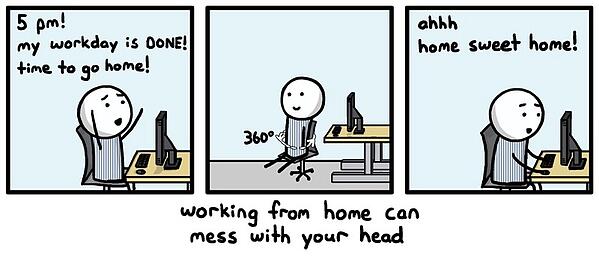
Help your people find their rhythm and avoid burnout
With the shift to remote work, it's likely that the routines of many of your people have changed. Even if they had great habits before COVID, it's a good idea to bring it up again and to see how well they've adjusted since.
To find out if people are dealing with this issue, you can ask them questions like
- How is your work-life balance right now? What would you like to change about it?
- How much time are you setting aside for yourself each day?
- How often do you take breaks during work? What helps you recharge when you do?
- How do you feel your energy levels are at work right now: strong and motivated, okay, or feeling kind of run down or burnt out?
- How have your routines changed since you shifted from office work to working remotely? What's worked better? What do you want to change?
By talking about these issues head on, you can help your team members make adjustments to their routine, work hours, and habits. This is exactly the kind of conversation good managers have with their team, and may otherwise go unspoken; rarely does anyone want to admit they're feeling lonely and overworked, but they will talk about it if asked.
If you want more in-depth advice on how to help your employees structure their day and unplug, you can start by reading these articles:
- Avoiding Employee Burnout: How to Help You & Your Team Thrive in Quarantine
- 3 Crucial Keys to Helping Your Team Transition to Remote Work Effectively
- 45 Questions to Ask Remote Employees
- 5 Things You Didn't Expect When Managing Remote Teams in COVID (and what to do about it)
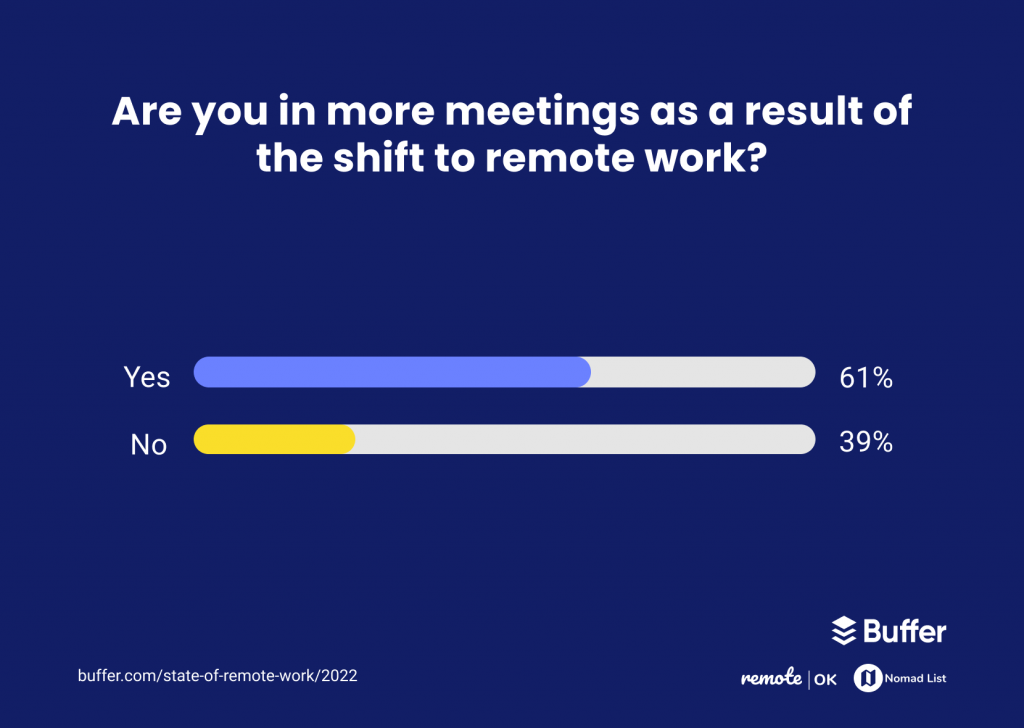
Death by meeting is still a thing
Shifting to remote work has caused all of us to lose some precious face-to-face time. To compensate, we got into the habit of scheduling meetings for just about anything. Whether it’s a status update, catching up, or solving a problem, these meetings can easily pile up.
In the 2022 Buffer survey, 61% of correspondents said they were spending more time on meetings as a result of shifting to remote work. When you compare that to 52% in 2021, the jump seems pretty significant. Unfortunately, there’s no data about this from 2020, so we don't know how this compares to pre-pandemic levels.
However, if you're thinking that there's more meetings now, you're probably right. Data published on HR Reporter show that 55% of American remote workers have more meetings now than they did in person. Even worse, 35% of those workers only have 30 minutes or less between meetings
Unfortunately, the more often we have meetings, the more difficult it is to regain focus. According to a University of California Irvine study, “it takes an average of 23 minutes and 15 seconds to recover your concentration from a distraction.” Now, imagine if most of your day is in meetings...
Zoom fatigue is causing us headaches
Yes, death by meeting is still a very real threat to our productivity. And death by virtual meeting has a name of its own now - Zoom fatigue. ‘Zoom fatigue’ is a term coined by Professor Jeremy Bailenson, founding director of the Stanford Virtual Human Interaction Lab.
His research showed that spending hours every day on communication platforms can have serious mental and physical consequences on people, including:
- Feeling emotionally drained
- Feeling physically tired - even if you didn’t move around a lot throughout the day
- Avoiding social interactions after your virtual calls.
To avoid Zoom fatigue, you and your team need to learn how to function asynchronously.

Learn asynchronous communication to avoid meeting fatigue
With teams now hiring people around the country, and the world, it's possible to be in meetings round the clock. To avoid this, embracing asynchronous communication across is a must for companies today.
The easiest thing to do when working remotely is to schedule another Zoom call or meet to discuss something that could have been an email or previously a 2 minute chat in the hallway. However, all those calls come at a high cost. There’s no time to get real work done if meetings keep interrupting you all day. And on top of that, it's exhausting.
In contrast, asynchronous communication can help you share key information with your team without the need for everyone on a call together. It gives everyone a chance to think about things and provide their input at a time that's best for them.
Doist founder Amir Salihefendić has a few fantastic recommendations for asynchronous communication, including:
- Treat writing and communication as core skills to master. Practice them and set a strong example of it yourself.
- Teach people how to spend time productively while waiting for an answer. This way, you won't be putting out fires all the time.
- Use tools built for async communication to make this adoption easier (e.g., Github pull requests, Basecamp for project management, Google docs for notes, key discussions, and information dissemination, etc).
- Give people time to reflect on something and then set reasonable deadlines on when you expect an answer
If you need more help setting up more intentional processes to support remote team members and get better at asynchronous communications, check out these posts:
- Your Guide to Synchronous vs. Asynchronous Communication
- 13 Challenges You didn't Plan for When You Started Hiring Remote Employees (and what to do about them)
- Remote Management: 41 Questions to Ask Your Hybrid Team

How We Work Remotely Will Continue to Evolve - Work on These Areas to Prepare
From the outbreak of COVID-19 to today, there have been many changes to how we all work.
It’s become clear a huge number of companies are embracing remote work permanently (at least some of the time). This brings many challenges with hybrid teams you need to prepare for intentionally. Information inequality, isolation, and fewer career growth opportunities are just some of the issues you need to look out for.
Additionally, being able to unplug has remained the biggest concern of remote workers throughout 2021 and 2022. Unless you help your team find their rhythm and healthier routines, you risk them burning out.
Finally, participants in Buffer’s survey believe they are in more meetings than ever. Zoom fatigue is an issue that often flies under the radar. However, eliminating it will give your team the freedom from distractions they need to do their best work.
Use our tips to combine what you’ve learned from Buffer’s reports into a better remote work strategy.
Are you growing as a leader? Are you building the skills you need?
Whether your team is in office with you or remote, Lighthouse Lessons can teach you the skills you need to better lead, motivate, and grow your team. Let us help you navigate the unique challenges of being a leader like we helped Daniel by learning more and signing up here.





